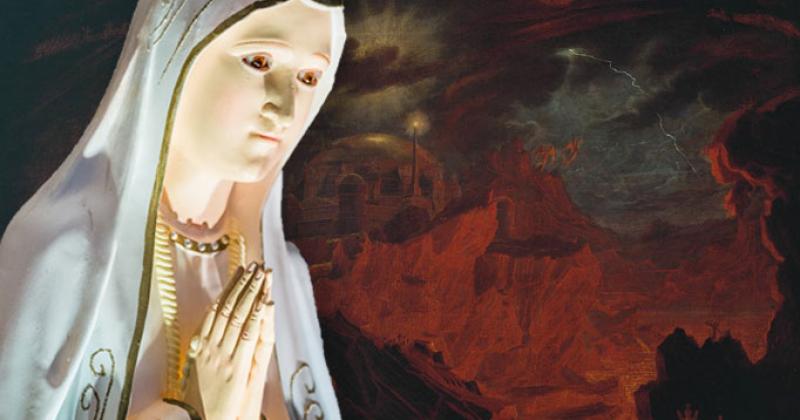To the children at Fatima 100 years ago, St. Faustina and millions of Catholics worldwide, hell is real. And, scary as such visions are, they echo a positive urgency to mercy.
Catholics currently find themselves between two remarkable events on their calendars, brought to us by two extraordinary ladies in our history and hearts and minds: April 23 was Divine Mercy Sunday, granted to us by the experiences of St. Faustina Kowalska, and May 13 is the feast of Our Lady of Fatima.
As to the latter, this May 13 will be more than a typical Our Lady of Fatima feast day: It is the centenary of Mary’s first appearance in Fatima May 13, 1917.
The closeness of these two events on our immediate calendar has prompted some to draw out comparisons. Here at the Register, Joe Pronechen wrote an excellent piece listing some parallels between Divine Mercy and Fatima, especially the crucial common message of repentance and mercy.
Yet there’s one commonality between the two that I’ve found most interesting and enlightening — even frightening: their jarringly similar visions of hell.
As for Fatima, that vision was given to the shepherd children — Lucia, Francisco and Jacinta — July 13, 1917. Granted by the Blessed Lady, the vision was horrible, monstrous and terrifying — so much so that, as the children were permitted this view, they were divinely infused with a protective grace that enabled them to observe the scene without being so terrified as to perish at the sight.
Lucia later described it as a “sea of fire,” filled with “demons and souls in human form, like transparent embers, all blackened or burnished bronze, floating about in the conflagration, now raised into the air by the flames that issued from within themselves together with great clouds of smoke … amid shrieks and groans of pain and despair, which horrified us.”
She said the demons could be distinguished by their “terrifying and repellent likeness to frightful and unknown animals, black and transparent like burning coals.”
It was after this vision that the Lady taught a special prayer to the shepherd children — what we now know as the “Fatima Prayer” that ends each decade of the Rosary:
“O my Jesus, forgive us our sins, save us from the fires of hell, especially those in most need of thy mercy.”
That redemptive mission of mercy was precisely the one charged to Sister Maria Faustina Kowalska, who became Jesus’ specially appointed “Apostle of Mercy” — herald of a veritable ocean of mercy — to save sinners from the fires of hell. And it was 19 years after the Fatima children received their vision of hell that Faustina received hers.
The time was late October 1936. Faustina was doing an eight-day retreat that began on Oct. 20. It was one day during this retreat that she was led by an angel to what she called the “chasms of hell.” The Polish nun described it in her diary as a place of “great torture” and “fire that will penetrate the soul without destroying it — a terrible suffering.” This hell was filled with darkness, and, despite that darkness, “the devils and the souls of the damned see each other and all the evil, both of others and their own.”
Faustina also observed, Dante-like, special sections of hell reserved for specific agonies earned in this fallen world. “There are caverns and pits of torture where one form of agony differs from another,” she recorded in her now-famous diary. “There are special tortures destined for particular souls. These are the torments of the senses. Each soul undergoes terrible and indescribable sufferings related to the manner in which it has sinned.” (Dante called this form of punishment contrapasso, directly linked to the way that the sinner sinned.)
She said that what she was sharing was merely “a pale shadow of the things I saw. But I noticed one thing: that most of the souls there are those who disbelieved that there is a hell.”
In a situation akin to what the Fatima children reported, she added, “I would have died at the very sight of these tortures if the omnipotence of God had not supported me.”
And like the Fatima children, this vision was given to her less for her benefit than as a warning to larger humanity. She testified to her diary:
“I, Sister Faustina Kowalska, by the order of God, have visited the abysses of hell so that I might tell souls about it and testify to its existence.”
She therefore urged fervent prayer for the conversion of sinners to be saved from the fires of hell.
Some readers will find these two visions frightening in their similarity, which, of course, they are. But I also find their similarity ironically reassuring — reassuring in the sense that the two analogous visions and messages, received less than two decades apart, strike me as more believable because they are so comparable, given to totally separate people on separate occasions.
And moreover, scary as they are, they also echo a positive urgency to mercy. Through these visions and their messengers, the divine is giving us yet another chance. We’re being warned to get ourselves in order, to stop sinning and to seek conversion and redemption, before it’s too late.
Coming now, in 2017, the year after the Church’s Year of Mercy, the timing couldn’t be more acute.
